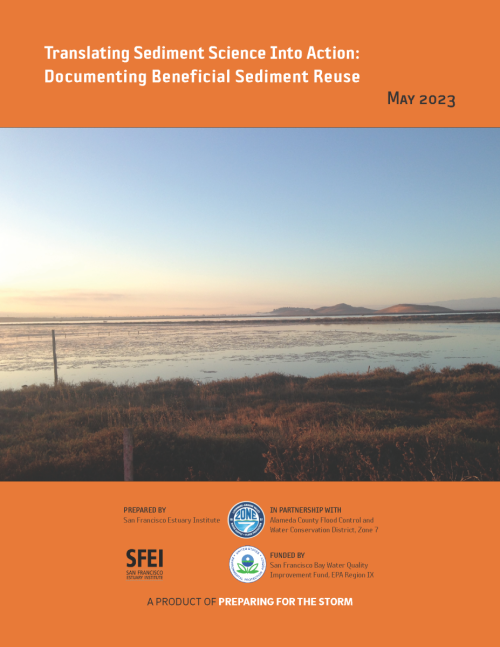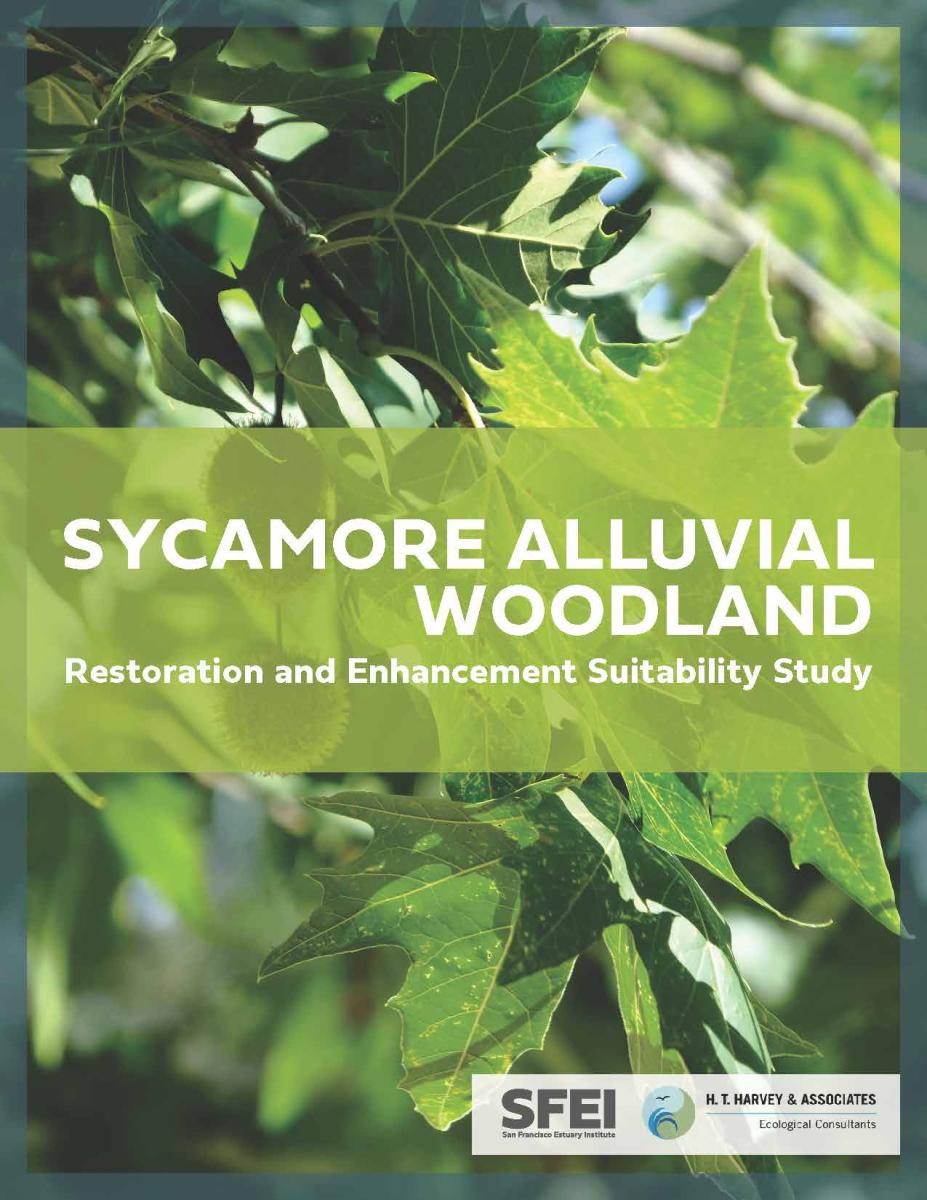Library
Our library features many hundreds of entries.
To search among them, click "Search" below to pull down options, including filtering by document type, author, year, and keyword.
Find these options under "Show only items where." Or you can also sort by author, title, type, and year clicking the headings below.
Export 49 results:
Filters: First Letter Of Last Name is P [Clear All Filters]
. 2007. 2006 RMP Annual Monitoring Results. SFEI Contribution No. 542. San Francisco Estuary Institute: Oakland.
. 2007. 2007 RMP Annual Monitoring Results. SFEI Contribution No. 572. San Francisco Estuary Institute: Oakland, CA.
. 2014. 2012 Annual Monitoring Results. San Francisco Estuary Institute: Richmond, CA.
. 2006. RMP Benthic Assessment Workshop.
. 2012. Historical Ecology of the McCormack-Williamson Tract: A Landscape Framework for Restoration. SFEI Contribution No. 674. Aquatic Science Center / San Francisco Estuary: Richmond, CA.
2023. Regional Analysis of Potential Beneficial Use Locations. Conducted for the San Francisco Bay Regional Dredged Material Management Plan. Prepared by the San Francisco Estuary Institute for the US Army Corps of Engineers, San Francisco District. SFEI Contribution No. 1178. San Francisco Estuary Institute: Richmond, CA.
2022. Adaptation Pathways: San Leandro Operational Landscape Unit. SFEI Contribution No. 1077. San Francisco Estuary Institute: Richmond, CA.
2023. Baylands Resilience Framework for San Francisco Bay: Wildlife Support. SFEI Contribution No. 1115. San Francisco Estuary Institute: Richmond, CA.
1988. Monitoring of Toxic Contaminants in the San Francisco Bay-Delta: A Critical Review. SFEI Contribution No. 152.
1987. Executive Summary of Toxic Contaminats in the San Francisco Bay - Delta and Their Possible Biological Effects. SFEI Contribution No. 139. San Francisco Estuary Institute: Richmond, CA. p 15.
1987. The Screening of Problems Relating to the San Francisco Bay_Delta. SFEI Contribution No. 138. San Francisco Estuary Insitute: Richmond, CA. p 77.
2008. RMP Sediment TIE Study 2007-2008: Using Toxicity Identification Evaluation (TIE)Methods to Investigate Causes of Sediment Toxicity to Amphipods. SFEI Contribution No. 561. San Francisco Estuary Institute: Oakland, CA.
2000. Investigations of Sediment Elutriate Toxicity at Three Estuarine Stations in San Francisco Bay, California. SFEI Contribution No. 374. San Francisco Estuary Institue: Richmond, CA.
1988. Monitoring of Toxic Contaminants in the San Francisco Bay-Delta: A Critical Review, Emphasizing Spatial and Temporal Trend Monitoring. SFEI Contribution No. 153. AHI: Richmond, CA. p 244.
1988. Executive Summary of the Monitoring of Toxic Contaminants in the San Francisco Bay-Delta: A Crtical Review. SFEI Contribution No. 151. San Francisco Estuary Institue: Richmond, CA. p 14.
1987. Toxic Contaminants in the San Francisco Bay-Delta and their Possible Biological Effects. SFEI Contribution No. 145. Aquatic Habitat Institute: Richmond, CA. p 472.
2011. RMP Sediment Study 2009-2010 Determining Causes of Sediment Toxicity in the San Francisco Estuary. SFEI Contribution No. 626. UC-Davis, Marine Pollutions Studies Laboratory.
2001. Sediment Toxicity Identification Evaluations San Francisco Bay RMP for Trace Substances - Progress Report. SFEI Contribution No. 46. San Francisco Estuary Institute: Richmond, CA.
2024. Petaluma River Watershed Contemporary Riparian Condition Assessment. Petaluma River Watershed Contemporary Riparian Condition Assessment. SFEI Contribution No. 1160. San Francisco Estuary Institute: Richmond, CA.
2004. Relative effects of fluvial processes and historical land use on channel morphology in three sub-basins, Napa River basin, California, USA. IAHS, International Association of Hydrological Sciences 288.
2009. A Sediment Budget for Two Reaches of Alameda Creek: support for flood control channel management.
2009. Alameda Creek Bulk Sediment Study Technical Memorandum. San Francisco Estuary Institute: Oakland,Ca.
2015. Sediment Supply, deposition, and transport in the Flood Control Facilities of Arroyo Mocho and Arroyo Las Positas from 2006-2014. . SFEI Contribution No. 771. San Francisco Estuary Institue: Richmond, CA.
2020. Summary of Water Year 2017 precipitation, discharge, and sediment conditions at selected locations in Arroyo de la Laguna watershed, with a focus on Arroyo Mocho. SFEI Contribution No. 912. San Francisco Estuary Institute: Richmond, CA.
This report summarizes the precipitation, discharge, and sediment conditions observed from October 1, 2016 to September 30th, 2017 (Water Year (WY) 2017) in the Arroyo de la Laguna watershed, with a focus on the Arroyo Mocho watershed. This information was collected by the Zone 7 Water Agency to support operation and maintenance of their flood control facilities. Additionally, this and similar information collected in WY 2018 and 2019 will be utilized to update the Arroyo Mocho watershed sediment budget (Pearce et al, 2020).
2021. Towards a Coarse Sediment Strategy for the Bay Area. SFEI Contribution No. 1032. San Francisco Estuary Institute: Richmond, CA.
Historic and current regional management of watersheds and channels for water supply and flood control across the San Francisco Bay Area has cut off much of the coarse sediment that was historically delivered to the Bay. Here we define coarse sediment as having grain sizes larger than 0.0625 mm, which includes sand, gravel and even cobble, as opposed to fine sediment that includes clay, mud and silt. Future projections indicate that sediment supply will not meet the demand from extant and restored tidal marshes to keep up with sea level rise.
The US EPA Water Quality Improvement Fund Preparing for the Storm grant has funded the Zone 7
Water Agency, the San Francisco Estuary Institute and the San Francisco Bay Joint Venture to support
the future development of a successful regional coarse sediment reuse strategy. Development of
such a strategy requires an understanding of logistical and regulatory hurdles and identification of key
strategies for breaking down barriers. One potential solution for meeting the sediment demand along
the Bay margin is to utilize coarse sediment that is removed from flood control channels by public
agencies. To-date, very little of this sediment that is removed is beneficially reused for restoration
along the Bay shoreline. The current economic and regulatory framework around sediment removal
presents many challenges, barriers and lack of incentives for agencies to reuse their sediment.
This document represents a step forward towards beneficially reusing coarse flood control channel sediment by outlining reuse challenges, and identifying incentives for participation and potential solutions.
2023. Translating Sediment Science Into Action: Documenting Beneficial Sediment Reuse. SFEI Contribution No. 1124. San Francisco Estuary Institute: Richmond, CA.
 The Preparing for the Storm project, led by Zone 7 Water Agency (Zone 7) and funded by the US Environmental Protection Agency (EPA) Water Quality Improvement Fund, aims to develop science-based plans, strengthen existing and new partnerships, and pilot new methodologies for tackling these issues surrounding coarse sediment. As a task within this larger project, this report describes four projects in the East Bay that serve as case studies for beneficial reuse of sediment. Each example highlights a project with sediment that could be reused (in lieu of landfilling) or a project that needs additional sediment and could benefit from deliveries of sediment that normally would not have been beneficially reused.
The Preparing for the Storm project, led by Zone 7 Water Agency (Zone 7) and funded by the US Environmental Protection Agency (EPA) Water Quality Improvement Fund, aims to develop science-based plans, strengthen existing and new partnerships, and pilot new methodologies for tackling these issues surrounding coarse sediment. As a task within this larger project, this report describes four projects in the East Bay that serve as case studies for beneficial reuse of sediment. Each example highlights a project with sediment that could be reused (in lieu of landfilling) or a project that needs additional sediment and could benefit from deliveries of sediment that normally would not have been beneficially reused.
2023. Sycamore Alluvial Woodland Restoration and Enhancement Suitability Study. In collaboration with Alameda County Flood Control and Water Conservation District, Zone 7. Prepared for the US Environmental Protection Agency’s Water Quality Improvement Fund. SFEI Contribution No. 1128. San Francisco Estuary Institute: Richmond, CA.
 The “Sycamore Alluvial Woodland Restoration and Enhancement Suitability Study” addresses distribution and regeneration patterns and restoration strategies of sycamore alluvial woodland (SAW) habitat, a unique and relatively rare native vegetation community adapted to California’s intermittent rivers and streams. The report was produced by SFEI and H. T. Harvey & Associates, as part of the US EPA Water Quality Improvement Fund Preparing for the Storm grant, led by Zone 7 Water Agency.
The “Sycamore Alluvial Woodland Restoration and Enhancement Suitability Study” addresses distribution and regeneration patterns and restoration strategies of sycamore alluvial woodland (SAW) habitat, a unique and relatively rare native vegetation community adapted to California’s intermittent rivers and streams. The report was produced by SFEI and H. T. Harvey & Associates, as part of the US EPA Water Quality Improvement Fund Preparing for the Storm grant, led by Zone 7 Water Agency.
2023. McCosker Creek Restoration and Public Access Project: Alder Creek Daylighting Additional Monitoring Elements - Final Report. SFEI Contribution No. 1157. San Francisco Estuary Institute: Richmond, CA.
2018. Blurred lines: Multiple freshwater and marine algal toxins at the land-sea interface of San Francisco Bay, California. Harmful Algae 73, 138-147 . SFEI Contribution No. 875.
2024. Microplastics Monitoring and Science Strategy for San Francisco Bay 2024 Revision. SFEI Contribution No. 1144. San Francisco Estuary Institute: Richmond, CA.
2021. An Examination of the Benefits and Trade-offs of Visitation and Recreational Use of Public Open Space. SFEI Contribution No. 1020. San Francisco Estuary Institute: Richmond, CA.
2021. Biophilia beyond the Building: Applying the Tools of Urban Biodiversity Planning to Create Biophilic Cities. Sustainability 13 (5).
In response to the widely recognized negative impacts of urbanization on biodiversity, many cities are reimagining urban design to provide better biodiversity support. Some cities have developed urban biodiversity plans, primarily focused on improving biodiversity support and ecosystem function within the built environment through habitat restoration and other types of urban greening projects. The biophilic cities movement seeks to reframe nature as essential infrastructure for cities, seamlessly integrating city and nature to provide abundant, accessible nature for all residents and corresponding health and well-being outcomes. Urban biodiversity planning and biophilic cities have significant synergies in their goals and the means necessary to achieve them. In this paper, we identify three key ways by which the urban biodiversity planning process can support biophilic cities objectives: engaging the local community; identifying science-based, quantitative goals; and setting priorities for action. Urban biodiversity planning provides evidence-based guidance, tools, and techniques needed to design locally appropriate, pragmatic habitat enhancements that support biodiversity, ecological health, and human health and well-being. Developing these multi-functional, multi-benefit strategies that increase the abundance of biodiverse nature in cities has the potential at the same time to deepen and enrich our biophilic experience in daily life.
2021. E-Bikes and Open Space: The Current State of Research and Management Recommendations. SFEI Contribution No. 1064. San Francisco Estuary Institute: Richmond, CA.
2020. Wildlife Habitat and Water Quality Enhancement Opportunities at Castlewood Country Club. SFEI Contribution No. 1003. San Francisco Estuary Institute: Richmond, CA.
Meeting human and ecological needs within San Francisco Bay’s watersheds is increasingly challenged by flooding, water quality degradation, and habitat loss, exacerbated by intensified urbanization and climate change. Addressing these challenges requires implementing multi-benefit strategies through new partnerships and increased coordination across the region’s diverse landscapes. Actions to improve water quality and enhance habitat for biodiversity in our highly developed and managed landscapes can help the region as a whole to build resilience to withstand current pressures and future change. The EPA-funded project, “Preparing for the Storm,” aims to address these challenges at the site- and landscape-scale through studies and implementation projects in the Livermore-Amador Valley. As part of this larger project, this technical report presents a synthesis of water quality and habitat improvement opportunities for a golf course of Castlewood Country Club.
1999. Cyanobacterial Populations in San Francisco Bay. SFEI Contribution No. 42. San Francisco Estuary Institute: Richmond, CA.
2002. Data Collection Protocol Survey Protocol for the California Red-Legged Frog (Rana aurora draytonii). SFEI Contribution No. 347. Rana Resources: Fremont, CA. p 15.
2002. Red-Legged Frog Protocol.
2002. Data Collection Protocols Surveying for the Salt Marsh Harvest Mouse [Reithrodontomys raviventris}, California Vole (Microtus califoricus) and other Small Mammals. SFEI Contribution No. 275. Rana Resources, San Jose State University: Fremont, Ca San Jose, Ca. p 14.

